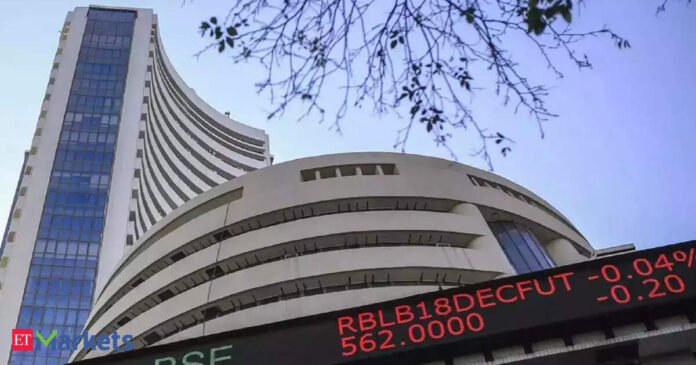Contents
Indian Equity Indices Decline for Third Straight Session Amid Disappointing Q1 Earnings
The Indian equity market witnessed a decline for the third consecutive session on Monday, with the NSE Nifty falling 0.6% to 24,680 and the BSE Sensex dropping 0.7% to 80,891, due to disappointing first-quarter earnings that raised concerns about the market’s elevated valuations. The broader market also experienced a sharper slide, with investors reducing their risky bets amidst growing uncertainty.
The decline in the Indian equity market on Monday was attributed to the disappointing first-quarter earnings of various companies, which cast doubt on the market’s elevated valuations. The NSE Nifty fell 156 points to finish at 24,680, while the BSE Sensex dropped 572.07 points to 80,891. The Nifty Mid-cap 150 and Small-cap 250 indices also declined 0.9% and 1.3%, respectively. In the past week, the benchmark index shed 1.6%, while the mid-cap and small-cap indices lost 3.1% and 4.1%, respectively.
Reasons Behind the Decline
According to Siddarth Bhamre, Head of Research at Asit C Mehta Intermediates, the market has been factoring in higher growth expectations into mid-cap and small-cap stocks. “So if these companies report lower growth numbers in the earnings, the selloff is that much more pronounced because the higher growth led these stocks to command a higher valuation multiple,” he said. The Nifty Realty Index tumbled 4.1%, while the metal index closed 1.2% lower. The Bank Nifty fell 0.8%, and the private bank and PSU Bank indices dropped 1.7% and 1.2%, respectively.
Market Sentiment and Expectations
The Volatility Index or VIX, which is a measure of the market’s fear gauge, gained 7% to 12.1 on Monday, indicating that traders expect higher risks in the near term. Out of the 4,299 stocks traded on the BSE, 2,951 declined, while 1,200 advanced, underscoring the weakness in the broader market. Vipin Kumar, AVP Equity Research & PMS (Derivatives & Technical Analyst) at Globe Capital Market, said, “Despite opening higher, the mid and small-cap segment saw a fall today driven by bearish sentiment as the benchmark Nifty remained below the key level of 24,800.”
Some key highlights of the market trends include:
* The NSE Nifty fell 0.6% to 24,680
* The BSE Sensex dropped 0.7% to 80,891
* The Nifty Mid-cap 150 and Small-cap 250 indices declined 0.9% and 1.3%, respectively
* The Nifty Realty Index tumbled 4.1%
* The metal index closed 1.2% lower
* The Bank Nifty fell 0.8%
* The private bank and PSU Bank indices dropped 1.7% and 1.2%, respectively
Foreign portfolio investors (FPIs) sold shares worth a net of Rs 6,082.5 crore on Monday, while their domestic counterparts bought shares worth Rs 6,764.6 crore. In July, overseas investors divested Rs 27,822.9 crore. Bhamre said, “The probability of disappointment is higher in the market rather than making money in the current set-up. We are not gung-ho on the market at least until December this year as the potential for decent upside is unlikely.”
Kumar said that the key support level is 24,000-24,400, with some value buying likely to emerge at 24,000 levels, but markets are likely to be in a short-term downtrend. “A bounce back is likely towards 24,900-25,000 levels in the near term as the markets are oversold in the short term. However, it is expected to be a selling opportunity as we are in a ‘sell on rise’ market,” he added.
Conclusion and Outlook
In conclusion, the Indian equity market declined for the third consecutive session on Monday due to disappointing first-quarter earnings, which raised concerns about the market’s elevated valuations. The broader market also experienced a sharper slide, with investors reducing their risky bets amidst growing uncertainty. The market sentiment is bearish, with traders expecting higher risks in the near term. The key support level is 24,000-24,400, and markets are likely to be in a short-term downtrend. However, a bounce back is likely towards 24,900-25,000 levels in the near term.
Keywords: Indian equity market, NSE Nifty, BSE Sensex, mid-cap and small-cap stocks, first-quarter earnings, market valuations, volatility index, foreign portfolio investors, domestic investors, market sentiment, support level, short-term downtrend.
Hashtags: #IndianEquityMarket #NSENifty #BSESensex #MidCapAndSmallCapStocks #FirstQuarterEarnings #MarketValuations #VolatilityIndex #ForeignPortfolioInvestors #DomesticInvestors #MarketSentiment #SupportLevel #ShortTermDowntrend
Source link
